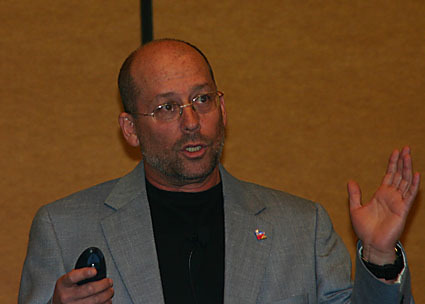Mooly Eden: A look into the origins of Core 2 Duo
Santa Clara (IL) - If you were to look into the story of Intel's latest microprocessors, you'd quickly learn that they aren't based so much on their seemingly most likely predecessor, the Pentium 4. Track down the family line and you end up at Banias, the first Pentium M. Join us for an interview with Mooly Eden, the man in charge of a project that convinced Intel to put the Gigahertz campaign into reverse.
One of the great advantages of being a technology journalist is the fact that we can receive deep insight into the technology that is penetrating our everyday life. An essential part of the job is being in direct contact with the source and developers of new technologies and, while we spend much of our time on the phone, we do get opportunities to meet developers and inventors of new products in person.
From time to time, when we meet unique personalities, we are pursuing interview appointments to find out more about a particular project and the person behind it. Mooly Eden, vice president and general manager of Intel's Mobile Platforms Group, is such a personality and given his background, a thorough interview on TG Daily is overdue. Eden joined Intel in 1982 as member of the startup staff for Fab 8 and eventually led the "Banias" project, which resulted in the launch of the First Pentium M in March 2003.
Mooly Eden
The Pentium M project is credited with prompting Intel to rethink its strategy to rapidly increase the clock speed and power consumption of processors. The Pentium M, designed in Israel, carries many of the genes of the Core 2 Duo, which enabled Intel to regain its leadership position in the CPU market.
We met with Mooly Eden in Intel's Santa Clara HQ not only to find out more about the history of Banias, but about a unique personality as well.
TG Daily: A few weeks ago, Intel introduced its more power-efficient Core microarchitecture, which has been considered as one of the firm's most significant product strategy turnarounds in quite some time. If we try to find the origins of this new thinking at Intel, we'll end up at Banias, the first Pentium M. You were in charge of that product and are often described as the 'man who changed Intel.' How does it feel to be credited with the invention of such an important product?
Get Tom's Hardware's best news and in-depth reviews, straight to your inbox.
Mooly Eden: I don't believe that there is a single person who can change Intel. Well, perhaps the CEO who is doing those big things. The article you are referring to had a nice headline, but I would not go to such an extreme.
TG Daily: So, if you did not invent the Banias processor, who did?
Mooly Eden: I am not a modest guy and I am not trying to shy away from the credit, but I don't think anyone at Intel can say "this is my baby." It is an effort of hundreds of people. I was lucky enough to have been the captain of the ship back then. And, if the ship is successful and wins the battle, the captain is getting a lot of credit. But there are many other people who do the work and deserve the credit. For example, if you are the manager, you should be wise enough to ask the right questions; you should be smart enough to pick up the right answers and you should navigate everything. I got the opportunity to do it. But there are also very talented architects - and those include the people who invented the architecture. As manager, you need to know how to how to solicit them, how to motivate them, how to encourage them and how to move them forward.
If someone needs to be credited with the invention of the die of the Pentium M, then I would have to say it was the team in Israel: The design team, because it was a brilliant idea for the best processor in the world. And the management because we took a big risk and said "we are going to change the paradigm." At the time, consumers were shopping for frequency and we said: "Guys, this is the end of the line. You need to do a right hand turn. Let's look at performance and other values beyond frequency."
Tom's Hardware is the leading destination for hardcore computer enthusiasts. We cover everything from processors to 3D printers, single-board computers, SSDs and high-end gaming rigs, empowering readers to make the most of the tech they love, keep up on the latest developments and buy the right gear. Our staff has more than 100 years of combined experience covering news, solving tech problems and reviewing components and systems.

